Intel Core i7 3820 Review: $285 Quad-Core Sandy Bridge E
by Anand Lal Shimpi on December 29, 2011 2:28 AM EST- Posted in
- CPUs
- Intel
- Sandy Bridge
- Sandy Bridge E
If you are a normal desktop user or even a power user with plans to run at over 4GHz, the vanilla LGA-1155 Sandy Bridge platform is good enough. You get some of the fastest CPUs on the market today paired with reasonably priced motherboards and the ability to use Quick Sync to transcode video...er...quickly. If that's not enough, Intel launched a higher end platform last month: the LGA-2011 Sandy Bridge E.
Take a regular Sandy Bridge, add PCIe 3.0 support, increase the number of PCIe lanes that branch off of the CPU (from 16 to 40 lanes), double the number of memory channels (4 x 64-bit DDR3 memory controllers) and you've got Sandy Bridge E and its LGA-2011/X79 platform. SNB-E is currently available in two forms: a $999 6-core Extreme Edition part (Core i7 3960X) and a $555 6-core unlocked version (Core i7 3930K). Neither is exactly cheap but if you need the PCIe lanes, core count and memory bandwidth, they are your only ticket.
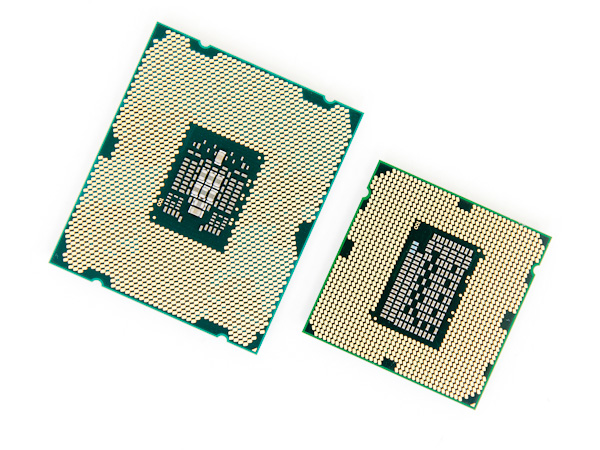
LGA-2011 SNB-E (left) vs. LGA-1155 SNB (right)
Sandy Bridge E is a fairly niche platform to begin with, but what about the niche within the niche (extremeception?) of users who just need the LGA-2011 platform but not necessarily a 6-core behemoth? For those users, there's the Core i7 3820:
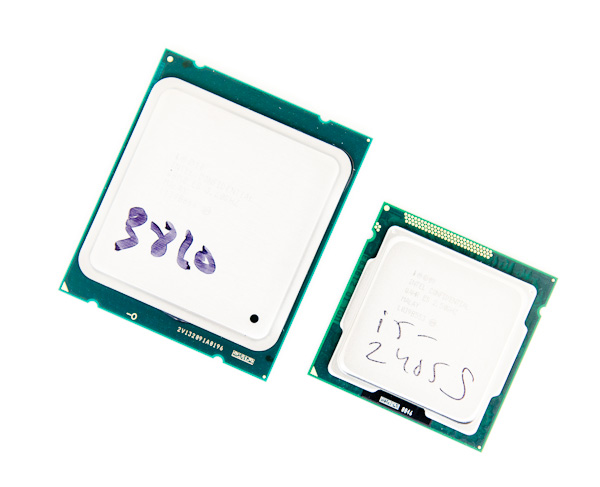
LGA-2011 SNB-E (left) vs. LGA-1155 SNB (right)
The Core i7 3820 is the first (and only) quad-core Sandy Bridge E CPU. It's so new that the chip isn't even available for sale nor will it be until early 2012. Unlike the relationship between the 3960X and 3930K, the 3820 is an entirely new die.
The chip features four Sandy Bridge cores and is paired with a 10MB L3 cache, giving it a slight advantage over the highest end LGA-1155 Sandy Bridge CPUs on the market today. The result is a die that's bigger than a regular SNB but significantly smaller than a 6-core SNB-E:
| CPU Specification Comparison | ||||||||
| CPU | Manufacturing Process | Cores | Transistor Count | Die Size | ||||
| AMD Bulldozer 8C | 32nm | 8 | 1.2B | 315mm2 | ||||
| AMD Thuban 6C | 45nm | 6 | 904M | 346mm2 | ||||
| AMD Deneb 4C | 45nm | 4 | 758M | 258mm2 | ||||
| Intel Gulftown 6C | 32nm | 6 | 1.17B | 240mm2 | ||||
| Intel Sandy Bridge E (6C) | 32nm | 6 | 2.27B | 435mm2 | ||||
| Intel Sandy Bridge E (4C) | 32nm | 4 | 1.27B | 294mm2 | ||||
| Intel Nehalem/Bloomfield 4C | 45nm | 4 | 731M | 263mm2 | ||||
| Intel Sandy Bridge 4C | 32nm | 4 | 995M | 216mm2 | ||||
| Intel Lynnfield 4C | 45nm | 4 | 774M | 296mm2 | ||||
| Intel Clarkdale 2C | 32nm | 2 | 384M | 81mm2 | ||||
| Intel Sandy Bridge 2C (GT1) | 32nm | 2 | 504M | 131mm2 | ||||
| Intel Sandy Bridge 2C (GT2) | 32nm | 2 | 624M | 149mm2 | ||||
There's a small improvement in base clock frequency over the fastest SNB (3.6GHz vs. 3.5GHz) but max turbo remains unchanged at 3.9GHz. For single threaded applications the 3820 should be just as fast as a Core i7 2700K or a 3960X. The same is true for if all heavily threaded workloads, at least when compared to other quad-core parts (the 3960/3930 still maintain an advantage because of their two additional cores).
| Processor | Core Clock | Cores / Threads | L3 Cache | Max Turbo | Max Overclock Multiplier | TDP | Price |
| Intel Core i7 3960X | 3.3GHz | 6 / 12 | 15MB | 3.9GHz | 57x | 130W | $990 |
| Intel Core i7 3930K | 3.2GHz | 6 / 12 | 12MB | 3.8GHz | 57x | 130W | $555 |
| Intel Core i7 3820 | 3.6GHz | 4 / 8 | 10MB | 3.9GHz | 43x | 130W | $285 |
| Intel Core i7 2700K | 3.5GHz | 4 / 8 | 8MB | 3.9GHz | 57x | 95W | $332 |
| Intel Core i7 2600K | 3.4GHz | 4 / 8 | 8MB | 3.8GHz | 57x | 95W | $317 |
| Intel Core i7 2600 | 3.4GHz | 4 / 8 | 8MB | 3.8GHz | 42x | 95W | $294 |
| Intel Core i5 2500K | 3.3GHz | 4 / 4 | 6MB | 3.7GHz | 57x | 95W | $216 |
| Intel Core i5 2500 | 3.3GHz | 4 / 4 | 6MB | 3.7GHz | 41x | 95W | $205 |
There's no on-die GPU, no heatsink/fan in the box and this isn't a fully unlocked part so the 3820 is actually cheaper than most of the high-end Sandy Bridge CPUs: it's priced at $285. If it weren't for the fact that you'll still need to spend over $200 on a motherboard I would say that the 3820 is a steal.
Overclocking
Let's start with the basics. All Sandy Bridge CPUs are clock locked by default, they can't operate at frequencies other than what they're sold at. There are two exceptions to this rule. All Sandy Bridge CPUs that support Turbo Boost are partially unlocked. Not only can they turbo up to frequencies that are higher than their default clock, but they can also be overclocked to frequencies even higher than their turbo speeds. By default, all Turbo enabled Sandy Bridge CPUs can be set to run at up to four bins (4 * bclk or 400MHz by default) higher than their standard turbo frequencies:
The second exception is any of the K or X-series SKUs. If your Sandy Bridge model number ends in a K or X, then the chip is fully unlocked and can be overclocked up to 5.7GHz using only clock multiplier adjustments.
The Core i7 3960X and 3930K fall into the latter category, which makes overclocking them a breeze. The 3820 on the other hand is partially unlocked, which means that we can run it at up to 4.3GHz using multiplier adjustments alone. Note that the 4.3GHz limit only applies to the 1-core active state, in the worst case scenario of all cores active with no room to turbo the highest operating frequency of the chip when overclocked would be 4.0GHz.
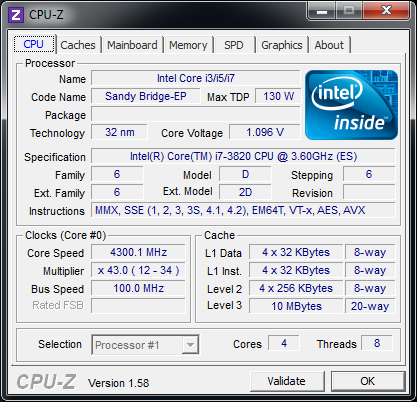
The max 3820 overclock without touching bclk settings
While these aren't bad targets, they're not all that exciting either. Thankfully Sandy Bridge E makes it even easier to overclock through the use of a few higher bclk frequencies. By default Sandy Bridge uses a 100MHz bclk, but SNB-E allows for 125MHz, 166MHz and 250MHz options as well. The 166/250MHz settings are a bit too aggressive, but the 125MHz bclk setting proved to be the perfect companion for the 3820.
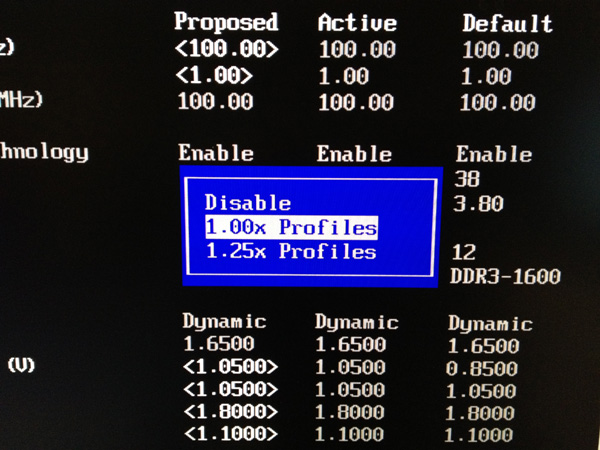
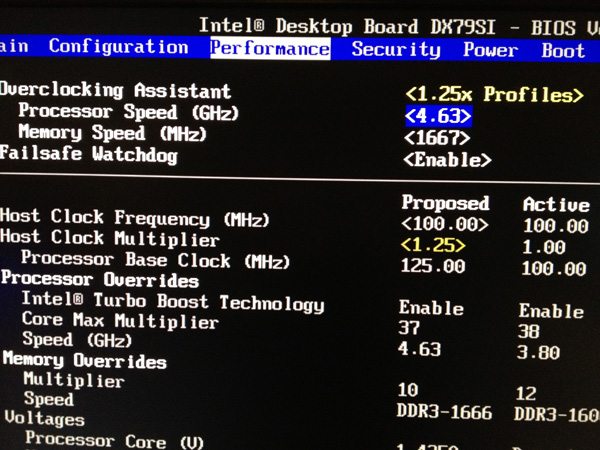
Intel's DX79SI makes it extremely easy to overclock, especially with the latest BIOS update. There are built in overclocking profiles for each bclk setting that you can choose from. I simply selected the 1.25x (125MHz) profile option and then went through the list of target frequencies until I found one that seemed promising. I also went in and tweaked some of the settings myself to get a bit more clock speed (4.63GHz is the fastest profile this board allows by default) and improve stability. In the end I was fairly pleased with what the 3820 could do: 4.75GHz with Intel's RTS2011LC closed loop cooling system.
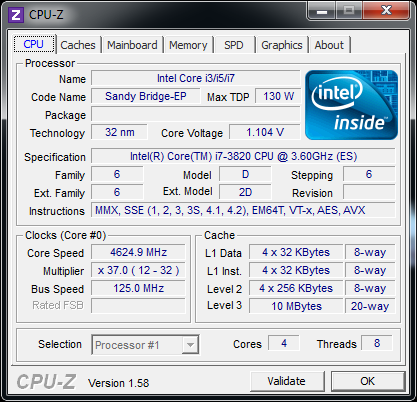
Now we're talking
I couldn't get the 3820 as stable as I would like at 4.88GHz and 5GHz was unfortunately out of the reach of my sample. I can't really complain about 4.75GHz from a $285 chip though, especially without resorting to anything too exotic from a cooling standpoint. Overclocking is also extremely effortless thanks to the new bclk options on SNB-E. Although the Core i7 3820 isn't an unlocked part, that doesn't limit how far (or how easily) it can be overclocked. A big part of the ease of overclocking is due to how good of a job Intel did on the DX79SI BIOS options, but from what we've seen the third party boards also do a decent job of simplifying the process.
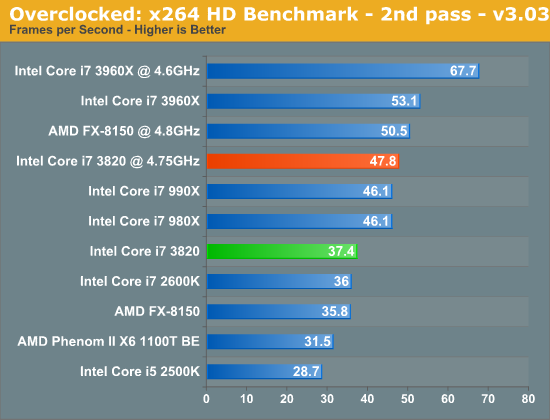
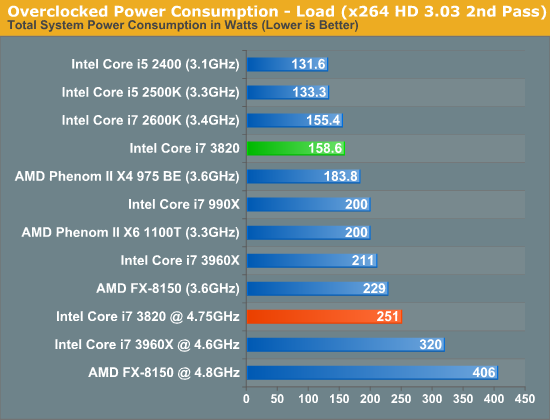
The Test
To keep the review length manageable we're presenting a subset of our results here. For all benchmark results and even more comparisons be sure to use our performance comparison tool: Bench.
| Motherboard: |
ASUS P8Z68-V Pro (Intel Z68) ASUS Crosshair V Formula (AMD 990FX) Intel DX79SI (Intel X79) |
| Hard Disk: |
Intel X25-M SSD (80GB) Crucial RealSSD C300 |
| Memory: | 4 x 4GB G.Skill Ripjaws X DDR3-1600 9-9-9-20 |
| Video Card: | ATI Radeon HD 5870 (Windows 7) |
| Video Drivers: | AMD Catalyst 11.10 Beta (Windows 7) |
| Desktop Resolution: | 1920 x 1200 |
| OS: | Windows 7 x64 |


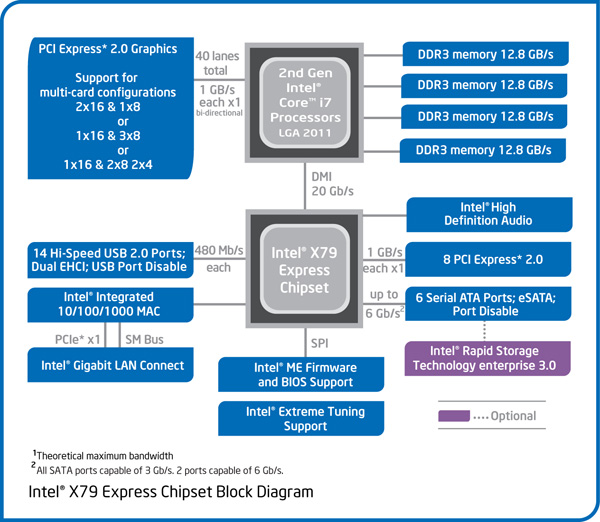









84 Comments
View All Comments
Roland00Address - Friday, December 30, 2011 - link
Yes the memory is cheaper (about $160). It is not "much much cheaper" (your words) anymore.An i7 2600k is $299 at amazon.com and newegg with free shipping and no tax in many states. That is a difference of +15 compared to the speculated price of 285 for the core i7 3820 (so a total of +175 for memory and cpu)
x79 motherboards cost between $215 to $470 on newegg. Cheapest board with 8 ram slots is $280
p67 motherboards cost between $95 to $310 on newegg
z68 motherboards cost between $90 to $340 on newegg
So you may save $175 on cpu and memory but you are going to spend another $100 ish on the motherboard making your savings less than a 100 dollars. A hundred dollars is not a small amount but we are probably talking all said and done talking about a computer that is going to cost between $1000 and $1500 to build, thus a 100 dollars is between 6 to 10% of the computer price.
There is a reason to get the x79 chipset, but if you are getting it due to memory, please do it so you can use you 64 GBs of memory instead of a mere 32. Do it for that reason or do it for the 6 core cpus, the pci-e . Do not get a x79 chipset just so you can go cheap on the memory and only get 32 GBs.
Do not wait another 3 months so you can save a small amount on memory.
Ammaross - Thursday, December 29, 2011 - link
Article: "If you're seriously considering anything in the SNB-E family, the latter [Ivy Bridge] isn't going to matter and the former will be of arguable value"piroroadkill: "Anyone who wanted a system of this performance already bought a 2500 or 2600K and overclocked the balls off it..."
With tri-gate, die-shrink, and small bump in performance, IVB will be a nice setup due to being highly overclockable (I hope!). If SNB can OC to ~4.5 on air (running 4.4 on my rig), IVB with die shrink would hopefully manage something approaching 5ghz (remember, tri-gate does a better job with power flow and reception at lower voltage or higher speeds...). And the pricing lineup has already been leaked and shows fairly similar pricing to SNB launch, so I'm just sitting on my hands until April.
p05esto - Thursday, December 29, 2011 - link
I've got an i7 940 system and skipped SB and SB-E, but Ivy is my upgrade plan at the moment. SB-E let me down, so I'm waiting till April now. And even then, my i7 940 on SSD does everything I need it to do and FAST..... it's just an upgrade itch that needs to be scratched every couple years (we're suckers perhaps).Coup27 - Thursday, December 29, 2011 - link
On the chipset block diagram, it says PCI Express 2.0 is branching off the CPU and also the chipset? Shouldn't that be 3?darckhart - Thursday, December 29, 2011 - link
Yes that confused me a bit as well. Or is that pcie v3.0 only off the cpu and v2.0 off the x79?deruberhanyok - Thursday, December 29, 2011 - link
Every time I see the "i7 3xxx" number I get excited and think someone got an early Ivy Bridge sample.Then I remember that Intel couldn't even stick to their own naming convention for two generations of the Core iX series. :(
p05esto - Thursday, December 29, 2011 - link
No kidding, that crap pisses me off. Why is so damn hard to come up with a simple naming convention that is intuitive and can be used for decades? Doesn't have to be fancy, they could prefix the convention with some silly name like Pentium, Core i7 or whatever but then give the freaking thing some letter/number designation that clearly shows what is what. I could come up with 10 different numbering schemes without even trying!descendency - Thursday, December 29, 2011 - link
Yeah. I don't get why they can't just name things likei3s...2100,2150,2200,2250
i5s... 2300, 2350, 2400, 2450
i7 (1155)...2500, 2550, 2600, 2650
i7 (2011)... 2700, 2750, 2800, 2850
with Extreme chips being 2900 X...
add in K, X, S and whatever other letters you want at the end
Then, when Ivy Bridge comes out, change those 2s to 3s... Oh. and when Haswell comes out... make those 3s into 4s... maybe even have an i3 2270 when you want to sell the better binned chips at a higher price.
dj christian - Thursday, January 5, 2012 - link
I don't get it, why would you sell the i3 2270 at a higher price? The SB is in it's way out..descendency - Thursday, December 29, 2011 - link
I know it would be expensive, but it would be nice occassionally to get a review of an entire platform and what is possible on it.For example, what FPS could you get in 6 monitor setups with 4x GPUs on SNB-E vs SNB. (or something like that)
How much does extra ram really benefit in those kinds of applications.
It just doesn't make sense to review all CPUs on even planes because all CPUs are not designed to do what some CPUs are and that's why they are 500-1000 dollars each.